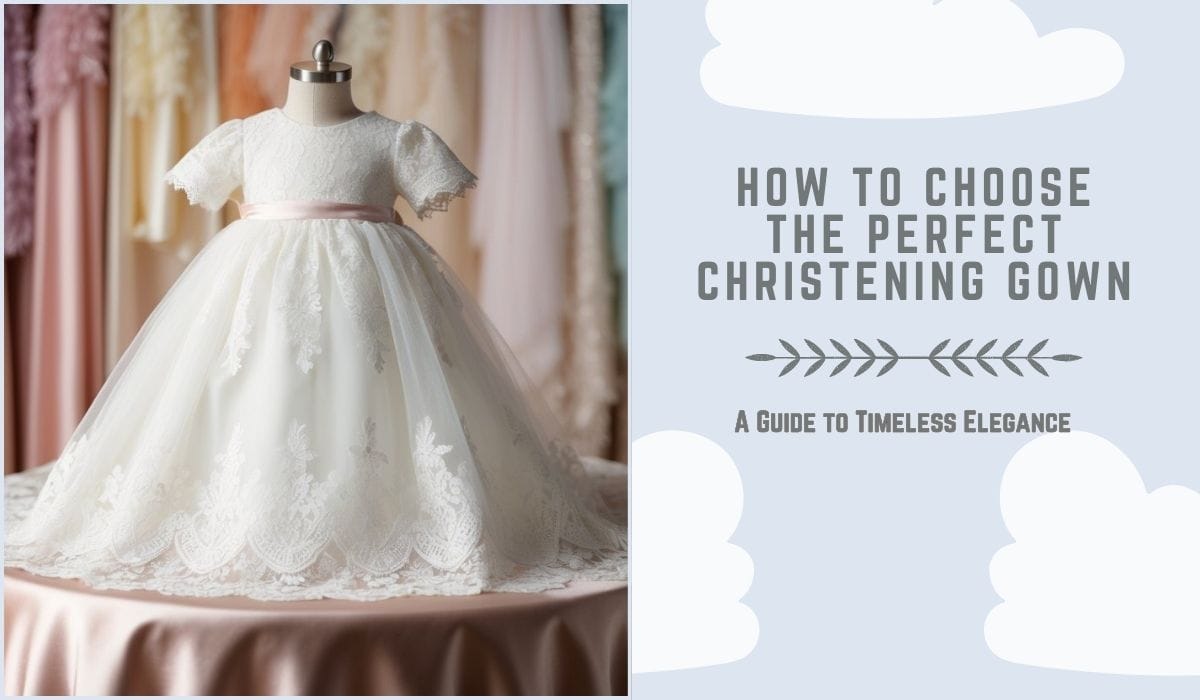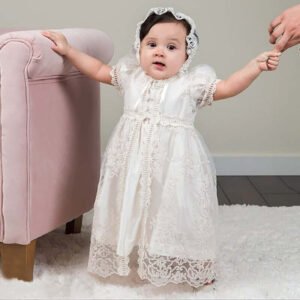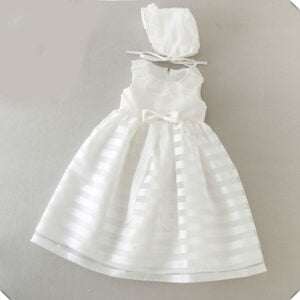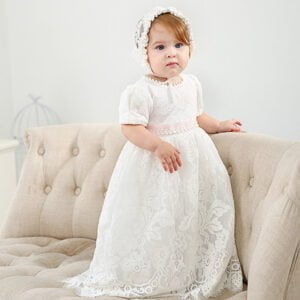Choosing the perfect christening gown for your little one can be a joyful yet challenging task. As a mum who’s been through this process, I know how special this moment is. The ideal christening gown should be comfortable, beautiful, and reflect the significance of the occasion.
When I picked out my baby’s gown, I focused on soft fabrics like cotton or silk that would be gentle on their delicate skin. I also looked for styles that were easy to put on and take off, which made the day much smoother. Remember, your baby will be the centre of attention, so a gown that allows for easy movement is key.
I found that considering family traditions can add a lovely touch to the outfit choice. Some families pass down christening gowns through generations, which can be a wonderful way to connect your child to their heritage. If you’re starting fresh, look for a gown that could become a cherished heirloom for future christenings in your family.
On This Page
Key Takeaways
- Choose a gown made from soft, comfortable fabric for your baby’s sensitive skin
- Consider family traditions or heirloom qualities when selecting the christening outfit
- Opt for a practical design that allows easy dressing and movement during the ceremony
Understanding the Significance of a Christening Gown

A christening gown is a special outfit worn by babies during their baptism. It holds deep meaning and carries on important traditions. Let’s look at where these gowns come from and what they represent.
Historical and Religious Roots
Christening gowns have been used for hundreds of years. In the past, they were often made from a mum’s wedding dress. This linked the baby to family history. The gowns were usually white or ivory and very long. Some even had trains like wedding dresses!
The style copied clothes worn by adults. This showed the baby was joining the church as a new member. Fancy fabrics and trims were common, even for less wealthy families. People would save up to buy the best gown they could.
Over time, styles changed but the basic idea stayed the same. Today’s gowns may be shorter and simpler, but they still mark an important religious event.
Purity and Innocence
The white colour of most christening gowns stands for purity. It shows the baby is free from sin after baptism. The gown’s style also points to innocence. Lace, ruffles, and soft fabrics all give a pure, sweet look.
Some gowns have symbols sewn on them. Crosses, doves, or other Christian signs may appear. These add to the religious meaning of the outfit.
The gown’s beauty reflects how special the day is. It helps make the ceremony feel grand and important. At the same time, it wraps the baby in softness and comfort during a big event.
Selecting the Ideal Fabric and Style
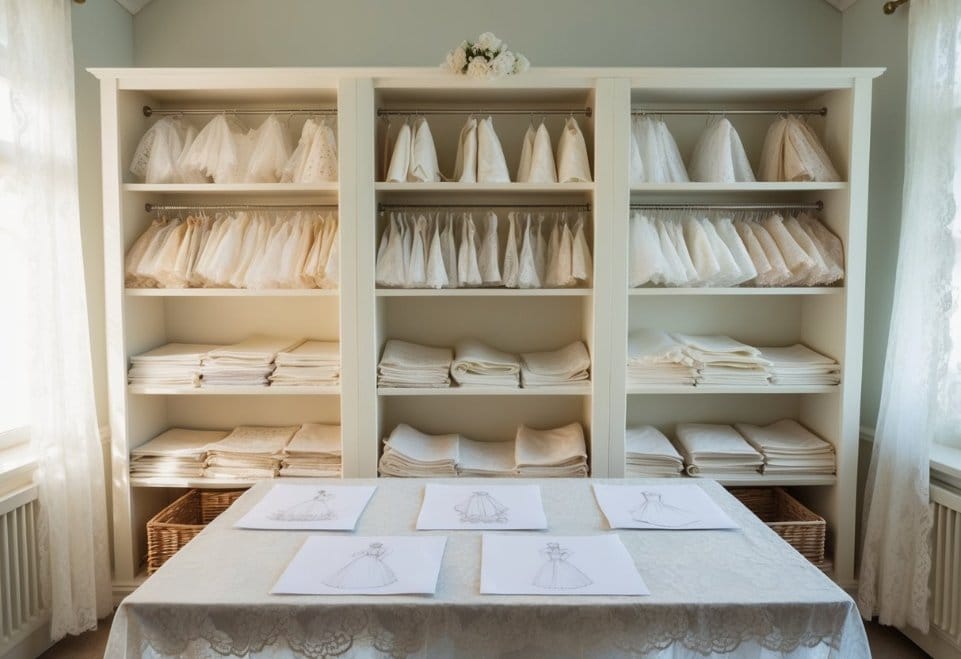
Choosing the right fabric and style for a christening gown is key. I’ll cover the pros and cons of different materials and designs to help you pick the perfect outfit for this special day.
Comparing Silk, Cotton, and Linen Options
Silk is a luxurious choice for christening gowns. It’s soft and has a beautiful sheen. But it can be pricey and hard to clean.
Cotton is comfy and easy to wash. It’s great for sensitive skin and warm weather. Many parents like it for its breathability.
Linen is durable and gets softer with each wash. It’s cool in hot weather but can wrinkle easily.
I think cotton is often the best pick. It’s comfy, affordable, and easy to care for. But silk or linen can be nice for a fancier look.
Traditional vs. Contemporary Designs
Traditional gowns are long and white. They often have lace, embroidery, or smocking. These styles are timeless and can become family heirlooms.
Modern designs offer more variety. They might be shorter or have colour. Some have cute details like bows or ruffles.
I’ve seen lovely contemporary outfits with Peter Pan collars or simple A-line shapes. These can be great for a less formal event.
Your choice depends on your taste and the type of ceremony. A classic gown suits a church service, while a modern outfit might work for a home baptism.
Essential Christening Outfit Accessories
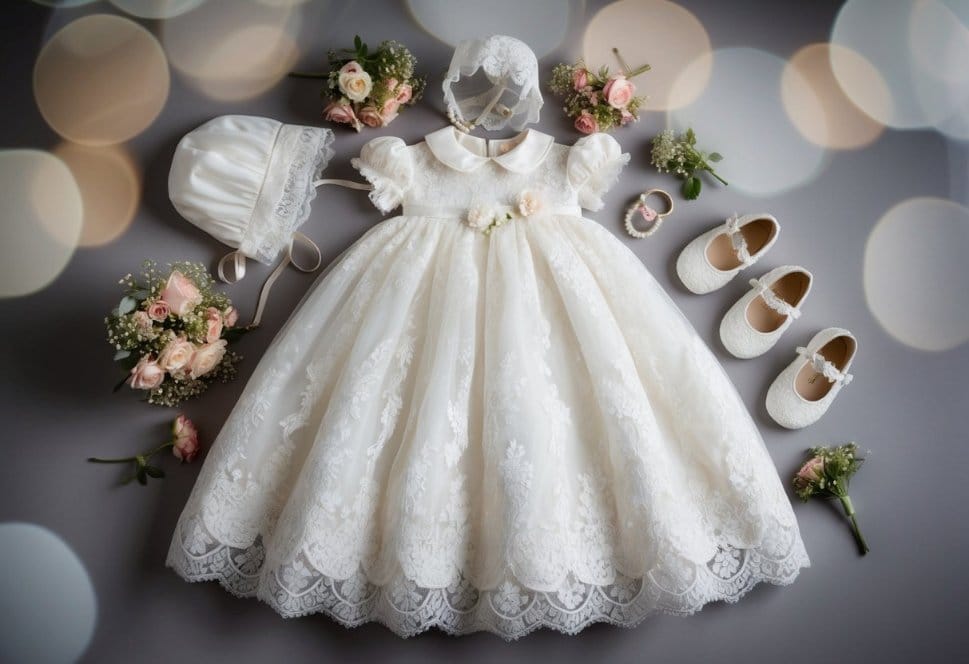
Accessories play a key role in completing the perfect christening look. The right extras can add special touches to the outfit while serving practical purposes during the ceremony.
Complementing the Gown with Shoes and Headwear
For footwear, soft white leather booties or satin shoes are classic choices. These match beautifully with christening gowns and keep tiny feet cosy. I recommend slip-on styles for easy dressing.
Headwear adds a lovely finishing touch. For girls, delicate lace or satin bonnets tie under the chin. Headbands with small bows or flowers are sweet options too. For boys, a simple cap can look smart.
When picking shoes and headwear, I always make sure they’re comfortable. Babies may fuss if items pinch or slip off easily. It’s best to try things on before the big day.
Additional Accessories for the Ceremony
A few extra items can be both useful and meaningful:
- Christening blanket: A soft white blanket to wrap baby in
- Bib: A special embroidered bib protects the gown
- Baptismal shell: Used to pour water during the ceremony
- Candle: Often lit as part of the service
I like to choose a bib that matches the gown’s style. Personalised options with the baby’s name or date can become lovely keepsakes.
For blankets, I opt for lightweight fabrics in warmer months and cosy knits for winter christenings. A simple white design works well with any outfit.
Choosing a Gown with Sentimental and Heirloom Quality

A christening gown can be more than just an outfit for a special day. It can become a cherished family keepsake passed down through generations. I’ll explain how to select a gown with lasting sentimental value and heirloom potential.
Heritage and Family Traditions
Family traditions add meaning to a christening gown. I’ve seen many families use the same gown for multiple generations. This creates a special link between family members across time.
Some families embroider names and dates on the gown or slip. This makes a lovely record of its history. Others add a bit of lace or fabric from a wedding dress or other family garment.
The British royal family is famous for their christening gown tradition. They’ve used the same gown since 1841, recently replaced with an exact copy.
To start your own tradition, pick a classic, timeless style. Avoid trendy designs that may look dated later. Choose durable, high-quality fabrics like silk or cotton.
Investing in Keepsakes
A christening gown can be a true investment piece. I always tell parents to think long-term when choosing one.
Look for signs of quality craftsmanship:
- Hand-sewn details
- Fine fabrics
- Sturdy construction
These features help ensure the gown will last for years. It’s worth spending a bit more for a gown that will stand the test of time.
Store the gown properly between uses. Use acid-free tissue paper and a sturdy box. Keep it in a cool, dry place away from sunlight.
Consider having the gown professionally cleaned and preserved after each use. This helps maintain its condition for future wearings.
Practical Considerations for Gown Selection
Selecting the perfect christening gown involves more than just aesthetics. I’ll cover key factors to ensure comfort and longevity for this special garment.
Finding the Perfect Size and Fit
When choosing a christening gown, size and fit are crucial. I recommend measuring your baby’s height and weight before shopping. Look for gowns with adjustable features like ribbons or buttons. This allows for a better fit and room to grow.
Soft, breathable fabrics like cotton are ideal for delicate skin. I prefer gowns with short sleeves for easy movement. Unisex styles often offer more versatility.
For boys, consider shorter gowns or romper-style outfits if you want a more traditional look. Girls’ gowns tend to be longer, but ensure the length doesn’t pose a tripping hazard.
Try the gown on your baby before the big day. Check for any tight spots or scratchy seams that might cause discomfort.
Caring for and Preserving the Gown
Proper care ensures your christening gown remains a cherished keepsake. I always check the care label before cleaning. Many gowns require hand washing or professional dry cleaning.
Store the gown in a cool, dry place away from direct sunlight. Use acid-free tissue paper to prevent yellowing. A sturdy box or garment bag offers extra protection.
Consider having the gown professionally cleaned and preserved after the ceremony. This helps prevent fabric deterioration and keeps it in pristine condition for future generations.
If you plan to use the gown for siblings, choose durable materials like cotton or polyester blends. Delicate fabrics like silk or lace may not withstand multiple wearings.
Regular inspection helps catch any damage early. Repair loose threads or buttons promptly to maintain the gown’s integrity.

